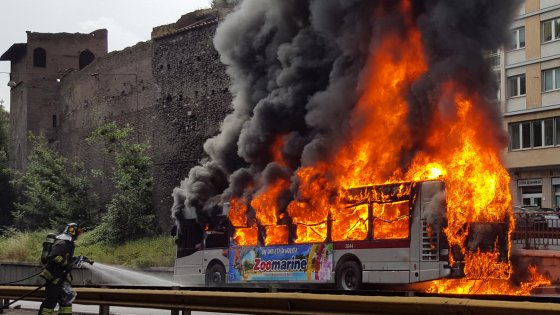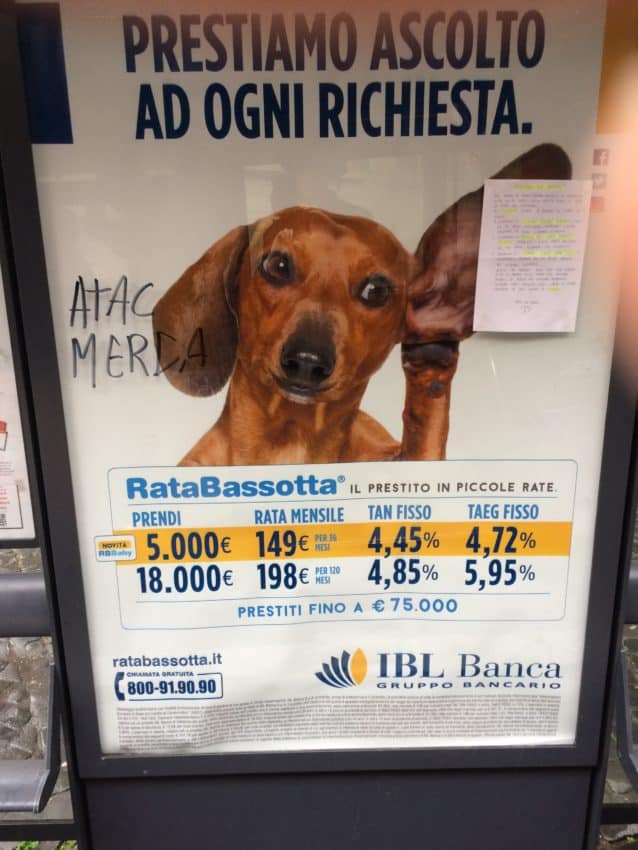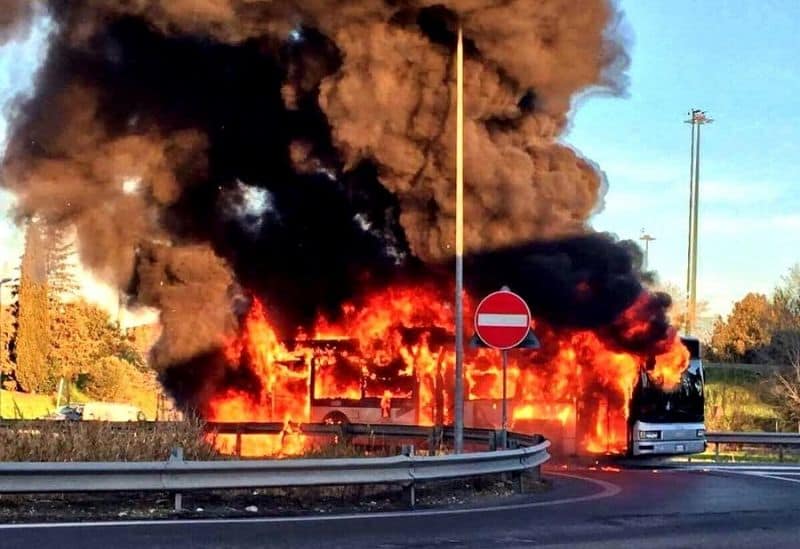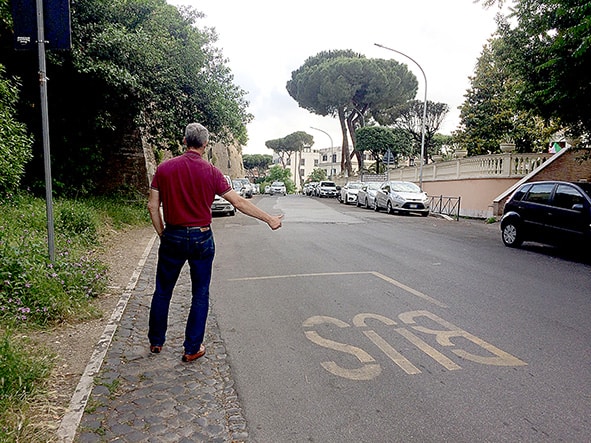Rome public transportation: A fiery controversy leaves me waiting for answers — and a bus

The app on my cell phone mocks me.
I stare at it and so often it lies. It’s maddening, like the worst girlfriend you ever had, one that keeps returning to haunt you. It must have a mind of its own. Can apps have evil souls? The app is called Citymapper. It gives me the public transportation route from any Point A to any Point B in Rome. It also lists the time of arrival of every bus to every bus stop. Only one problem.
The bus often doesn’t arrive. The app says “in 6 min” then “in 12 min” then in “8 min.” By the time the third bus was supposed to arrive and doesn’t, I’ve gone through my entire vocabulary of Romanaccio, the sub-dialect of the Roman dialect devoted entirely to profanity. The Romans around me remain calm, standing serenely as if this is as much a part of their day as their morning cappuccino.
Rome, once the most powerful society known to man, a city that has many of the world’s greatest museums, the best food and most beautiful architecture, struggles to move its citizens along its potholed streets. It has, without question, the worst public transportation in Europe. I know. I’ve been in every European capital except for a couple in Eastern Europe, and I never rent a car.
Besides buses not showing up, they are as packed as any in urban India. Buses and the limited three subway lines are often not air-conditioned, the bus tires go flat, drivers often go on strike and women get fondled.
Oh, yes. About twice a month a bus will inexplicably burst into flames.
It’s a mishmash of explanations, kind of like the fall of the Roman Empire. Corruption. Incompetence. Disorganization. And of course, the root of so many problems in Italy, the Mafia. But crime bosses are bit players, mere dime-store hoods in this drama that would make a good TV series — as long as the actors had cars to get to the sets. Good Lord, Rome has the only bus system in the world where the drivers don’t take tickets.
Me on a typical day trying to get around Rome. Photo by Marina Pascucci
After nearly 4 ½ years in Rome, public transportation is the one area where my honeymoon has worn off. I arrived in Rome from a completely different perspective than most locals. I was born, educated and worked my entire life in the western United States. Out West, public transportation is a rumor. Not one person from San Diego to Seattle could tell you what bus to take for any tourist site. Buses were just something that held up traffic. Growing up in Oregon 22 years and working in suburban Seattle for a year and a half and Las Vegas for 10, I didn’t once take a bus. Never. Ever. Not even one time.
In 23 years in Denver, particularly after living in Rome from 2001-03, I adopted more of a European lifestyle. I often took the bus downtown, site of my office and favorite watering holes. But in Denver, the only people who took the bus were the crippled, the poor and one environmentally conscious sportswriter. One New Year’s Eve, Denver’s bus company, the Regional Transportation District (RTD), offered free bus service all night. I took it downtown — alone. I was the only one onboard. Everyone else preferred to drive and drink. Then drive.
Is it any wonder that two years ago 10,500 people in the U.S. died from drunk driving?
RTD tries. Many Denver buses come only every 30 minutes until 8:30 p.m. Then it’s one per hour. I never blamed RTD, saddled with a true chicken-or-egg dilemma. They don’t have enough money to send out more buses; they don’t have more money because few people take the bus. For RTD to change its schedule it must first change American society. In the U.S., if you don’t have a car, you don’t have a life. Automobiles in America represent everything from your income to your political party. Yes, cars disgust me.
This is why when I retired to Rome its public transportation provided such a soft landing. From my perspective, Rome’s public transport was pretty damn good. At least, it was good enough to not add 25 percent to my yearly budget on a car — or add 25 percent more time wasted trying to find parking spaces. Buses go everywhere. The subway runs every five minutes. My Citymapper makes maps obsolete. I pay only 250 euros for a year’s pass. Last year I made 621 trips on buses, trams, the subway and regional trains. At 1.50 euro per ticket, that means the pass saved me 681.50 euros. That’ll buy a lot of wine.

But then I recently wondered about the price I really pay as I waited on busy Via Nazionale in a driving rainstorm, looking at the electronic board above the bus stop indicating my No. 170 bus would arrive in three minutes. It never came. Then it would arrive in seven minutes. It never came. Then eight minutes. By the third whiff, I hopped on another bus and patched together a new route home.
Frustrated? Yes. Fortunately, I didn’t burn alive.
In July 64 A.D. Rome burned for five days. To this day, no one knows who caused it. Many blamed Emperor Nero; Emperor Nero blamed the Christians. What ensued was the Roman Empire’s first persecution of Christians, or, as advertised outside the Colosseum concession stands during gladiator games, “Christians on a Stick.”
It’s nearly 2,000 years later, and Romans still can’t figure out what causes fires. Drivers blame bad maintenance. Rome prosecutors blame corruption. Romans blame skinflint passengers not buying tickets. Everyone, however, does agree with the numbers. On May 8, the ninth bus this year caught fire, this time on Via del Tritone, the popular street near Trevi Fountain. The last escaping passenger had barely stopped praying before another bus not far away went Mt. Vesuvius, too. That made it 10 in 2018, meaning we’re well on our way to surpassing last year’s total of 22 which surpassed the 2016 total of 14. That’s 46 bus fires in less than 2 ½ years.
Cities have 46 tire sales. They don’t have 46 bus fires.
The organization running Rome’s public transportation system is called Azienda per i Trasporti Autoferrotranviari del Comune di Roma, or ATAC. I’ve suggested changing the acronym’s meaning to Authoritarian Transport Agency of Corruption but something was lost in the translation. ATAC is as popular in Rome as box wine. It receives less respect than Starbucks. Nero remains more beloved. Mussolini has nothing on ATAC. At least he got the trains to run on time.

Romans have even adopted a name for the bus fires: flambus, a play off of ATAC’s previous name, Trambus. ATAC is just lucky the only person injured was a woman May 8 who had minor burns on her arm. In a city with 2,000-year-old backlit monuments and some of the most beautiful women in the world, it takes a lot for Romans to stop and stare. What usually does the trick is a 45-foot bus engulfed in flames rising to the sky and its tires exploding like small bombs.
One journalist was quoted in The Local, Rome’s English-language online news source, saying, “Only in Rome does a bus explode in the heart of the city and people immediately blame ATAC, with no thought of terrorism. It says a lot about our emergencies.”
Only in Rome can Islamic extremists become comic foils. After one bus fire, the TV ran a headline loop at the bottom of the screen reading, “Breaking News: ATAC claims responsibility for the attack in Rome.”
The center-right newspaper Il Foglio ran a headline over one fire story reading, “ATAC Akbar!”
Not everyone is laughing. Claudio De Francesco, the regional secretary of the Faisa-Confail union, which has gone on strike over the issue, told RomaToday that “It’s not safe with ATAC. By this point drivers can only pray that nothing happens, and we don’t even want to think about what will happen when it starts getting warmer.”
ATAC doesn’t just have bus fires. As an organization it’s a dumpster fire. It is 1.3 billion euros in debt and hasn’t turned a profit since 2006. Of its 1,350 buses, 500 were in the shop last June due to faulty air-conditioning or other problems, according to The Italian Insider. ATAC’s crack PR team jumped to the rescue, claiming the number was only 380. So it’s good ATAC cleared that up.
Many of the buses, including one that exploded this month, are 15 years old. Transportation experts, according to The New York Times, say a bus’s lifespan is about six or seven years. Thus, the list of maintenance problems would scare an Indy 500 pit crew: Overheated engines. Oil and gas leaks. Tires flat in a few hours. Jumping gears. Faulty brakes. One time last year the hand brake of a parked bus disengaged, sending it careening across Piazza Venezia, a massive roundabout with traffic similar to what swirls around the Arc de Triomphe. The bus hit a Smart car and injured a woman.
In 2016, a nuclear engineer named, appropriately, Manual Fantasia took over vowing to return ATAC to respectability. A 2017-19 industrial plan called for electronic tickets and an additional 500 administrative police to join 200 current ticket inspectors.
The electronic tickets never surfaced, meaning freeloaders are still hopping on and off the bus like children on a merry-go-round. In my previous three years in Rome, I was asked to show my pass, called a Metrebus Card, twice. In the last year, I have been checked about once every two months. Enforcement is improving. Getting caught means shelling out a 104-euro penalty on the spot, a fee that apparently deters no one. I see fewer tickets shoved into the buses’ little yellow machines than I do empty seats.
Adding to the nightmare are a fleet of drivers who no doubt hate life. You’ve heard stories about Rome’s traffic and drivers. Imagine spending eight hours a day driving a 45-foot bus through that mess. Adding ticket taking is apparently beyond their skill set, although they do manage to text at 50 words a minute during red lights.

Public transport strikes are also as common in Rome as wine tastings. No place else in the world do I know of where strikes are announced ahead of time. In fact, ATAC has its own web page listing all the fractured periods of operation and bus lines that shut down. And sometimes drivers act on their own. Strikes in Rome aren’t always over higher pay and better benefits. Sometimes they go like this:
Guido: “Hey, Giuseppe, you working today?”
Giuseppe: “Yeah, I’m driving the 170.”
Guido: “Want to take a break? I have a problem with my ex.”
Giuseppe: “Sure, I could use a caffe.”
So Giuseppe skips three rotations of his bus line while sitting at a sidewalk caffe listening to Guido verbally charbroil his ex-girlfriend. Then guys like me wind up walking through the rain to find another bus.
The most recent commissioner tried requiring drivers to punch a clock, which drivers responded with by striking and driving their routes slower than the horse-drawn carriages hauling tourists.
Every new elected official vows to stamp out Rome’s Whac-A-Mole corruption rackets. In 2015 Rome prosecutors investigated corruption in awarding contracts without due process, siphoning funds for sham consulting contracts and laundering money in San Marino bank accounts. The amount of dirty money involved topped 1 billion euros, according to Wanted in Rome.
In the past ATAC has been accused of printing counterfeit tickets, bribing politicians and nepotism.
Overlooking all this has been a string of mayors who have made no one forget Caesar Augustus. Gianni Alemanno (2008-13) of Silvio Berlusconi’s center-right Forza Italia party was tied to the Mafia. He allegedly accepted more than 125,000 euros from Salvatore Buzzi, the leader of Mafia Capitale, Rome’s local Mafia chapter. Buzzi’s previous claim to fame was on June 26, 1980, he turned on Giovanni Gargano, a corrupt judge who threatened to blackmail him, and stabbed him 34 times.
Buzzi and 40 others went to prison last year for pocketing public works funds. Consequently, like a junkie losing his dirty drug, the city fell apart. Alemanno’s successor, Ignazio Marino of the center-left Democratic Party, resigned after he was investigated for embezzlement, fraud and forgery tied to an expense receipt scandal.
His replacement and current mayor is Virginia Raggi, a 39-year-old former lawyer elected specifically from the outside of Rome’s stench-spewing political cauldron to clean up the corruption. But before she could show her clean, virgin hands, accusations of corruption started knocking off her cabinet members like plucked mallards. She went under investigation for abuse of office and giving false testimony during the investigation of one of her associates.
Alemanno and Marino were both cleared of charges as was Raggi of abuse of office although she remains embattled. Next month she goes on trial giving a false statement to an anti-corruption official, a procedure she encourages to clear her name. Consequently, Rome mayors seem no more empowered to clean up ATAC as they do the city streets, which have made Rome the filthiest capital in Europe.
Still, I happily hop on my No. 8 tram from my new apartment to Centro Storico. I’ll take the No. 871 to my lovely park, Doria Pamphilj. I’ll board the subway’s A Line to visit my Marina on the west side of town. I still love living here. It oozes history. It just doesn’t learn from it.
Yes, Western Civilization, Rome is burning again.


May 24, 2018 @ 8:58 am
Ric and I experienced the same initial euphoria when we first traveled to, then moved to, Rome. No need for a car! Reliable transportation! We walked to and from work most days but exploring the city, doing our errands, the bus was our choice from 2012 to 2016. When we arrived in 2016, Romans were screaming because the bus fare had gone up from 1 Euro to 1.50. Merde! In London and Paris, it is multiples of that! Imagine our shock when we first traveled to Paris and found buses ran on time, the app was precise and correct, and the bus drivers actually monitored fares!
Next time we visit, a piede or by taxi, I think.
May 24, 2018 @ 1:03 pm
Great article. Thank you.
June 1, 2018 @ 4:30 pm
Have you tried the app Probus Roma instead of Citymapper?
June 2, 2018 @ 7:55 am
It uses ATAC data to track the buses in real time and can show you where your bus is along the route. (Should be noted that I’ve never used Citymapper for transit and I don’t know its capabilities.)